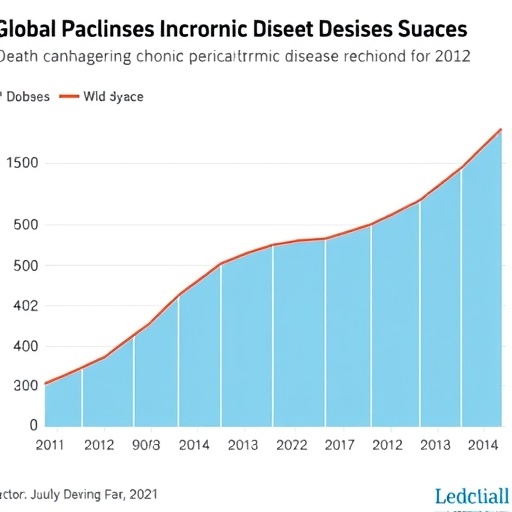Over the past decade, global mortality rates attributed to chronic, non-communicable diseases (NCDs) have exhibited a generally favorable trend, decreasing in roughly 80% of countries worldwide. These findings emerge from an extensive observational analysis conducted by researchers at Imperial College London, recently published in The Lancet. This comprehensive study not only quantifies country-specific progress in combating NCD mortality but also introduces a novel benchmarking framework that compares national trajectories against historical baselines and the most successful regional performers. The outcomes underscore both promise and persistent challenges in global health efforts targeting chronic diseases such as cancer, cardiovascular disorders, diabetes, kidney and liver diseases, and neurological conditions.
Non-communicable diseases constitute the leading cause of premature mortality globally, posing an immense burden on healthcare systems and economies. In response, numerous international commitments, including the United Nations Sustainable Development Goal (SDG) 3.4, have established clear targets for reducing premature deaths from NCDs by one-third by the year 2030. Political pledges and policy frameworks have proliferated, focused on prevention, early diagnosis, and improved treatment options. However, despite these extensive efforts, the new analysis highlights a worrying deceleration in the rate of decline for chronic disease mortality in many parts of the world during the decade spanning 2010 to 2019.
Intriguingly, the stagnation in progress is especially prominent among high-income nations, particularly in Europe, North America, Australasia, and the Pacific. These regions, despite their advanced healthcare infrastructures, have witnessed a marked slowing in reductions of NCD-related mortality rates compared with the preceding decade. The United States emerges as a notable example, performing worse than many peers by registering the smallest rate of decline in risk over this period. This suggests systemic issues that extend beyond mere healthcare access or technology availability, potentially implicating socioeconomic factors, lifestyle shifts, and public health policy effectiveness.
The study’s methodological rigor lies in its dual approach to monitoring mortality trends alongside benchmarking. It systematically evaluated cause-specific mortality data across nearly every country between 2001 and 2019. By contextualizing improvements relative to historical progress and pinpointing the best regional performers, the research sheds light on the pace and scale of change essential to meet international targets. This granularity facilitates precise identification of where efforts are faltering, and where replicable interventions might accelerate future gains.
One of the study’s critical revelations is that while absolute declines in mortality exist globally, the momentum necessary to achieve the UN’s 2030 goals is diminishing. Given that chronic diseases account for an overwhelming proportion of deaths and disability worldwide, slowed improvements risk undermining decades of public health advancements. The researchers warn that without renewed and intensified investment in NCD prevention and care strategies, especially those targeting high-risk and underserved populations, the world could fail to curb the devastating health impact of these conditions.
Chronic diseases often result from complex, multifactorial etiologies involving behavioral, environmental, genetic, and social determinants. Hence, the slowing decline in mortality rates may reflect emerging challenges, including aging populations, persistent disparities in healthcare accessibility, rising prevalence of obesity and sedentary lifestyles, and increasing exposure to environmental risks. Progressive health system reforms must consider these multifaceted drivers to craft effective interventions that can reverse current inertia.
Moreover, the authors advocate for enhanced surveillance infrastructure to enable continuous, high-resolution monitoring of disease patterns and intervention impacts. Real-time data analytics, coupled with machine learning techniques, could uncover nuanced risk factors and emerging trends. Such advancements would empower policymakers to tailor strategies dynamically, focusing resources on regions and demographics most at risk and identifying early signals of programmatic success or failure.
Beyond national health systems, international collaboration remains paramount. Sharing of best practices from regional leaders demonstrating notable success can inform global policy design. The study’s benchmarking approach highlights this potential by showcasing exemplary performers who have not only reduced mortality rates but also sustained acceleration in decline. Learning from these pioneers can reveal scalable strategies, from lifestyle modification campaigns to integrated chronic disease management models, valuable across diverse healthcare contexts.
The findings arrive at a critical juncture ahead of the upcoming Fourth High-level Meeting of the UN General Assembly, underscoring an urgent global call to action. The researchers emphasize the necessity for substantial reinvigoration of political will and funding allocations to NCD programs. Without such commitments, the progress made could plateau or regress, disproportionately affecting vulnerable populations who already bear a significant burden of chronic illness and premature death.
Technological innovations are also singled out as promising avenues. Breakthroughs in genomics, telemedicine, and digital health platforms offer novel opportunities for early detection, personalized intervention, and continuous patient engagement. When integrated with robust public health infrastructures and equitable care models, these advances can enhance both the quality and reach of NCD prevention and treatment services, potentially reversing current negative trends.
However, technological progress alone is insufficient without addressing social determinants of health. The study highlights that socioeconomic inequities, education gaps, and environmental factors continue to be significant obstacles to sustained reductions in chronic disease mortality. Holistic strategies that incorporate health promotion, community engagement, regulatory policies (such as tobacco or sugar taxes), and environmental protections will be critical to achieving broad-based, durable improvements.
In conclusion, while the global battle against chronic diseases has yielded encouraging results, this comprehensive analysis warns of a stagnation threatening to thwart further progress. The imperative for accelerated action, informed by rigorous data analysis and cross-sectoral collaboration, has perhaps never been greater. Building resilient health systems that can adapt to evolving disease landscapes and address underlying determinants will shape the trajectory toward the UN’s 2030 targets and beyond, ultimately improving longevity and quality of life for millions worldwide.
Subject of Research: People
Article Title: Benchmarking progress in non-communicable diseases: a global analysis of cause-specific mortality from 2001 to 2019
News Publication Date: 10-Sep-2025
Web References: http://dx.doi.org/10.1016/S0140-6736(25)01388-1
References: See paper
Keywords: Diseases and disorders, Health and medicine




